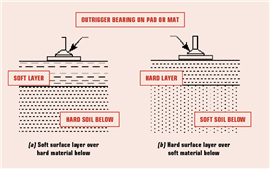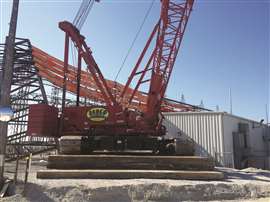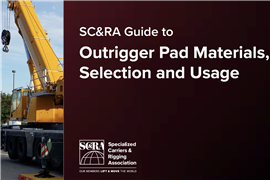Ground stabilization and the proper set up of cranes
07 September 2023
David Duerr discusses why it’s important to not gloss over weak soil and rules of thumb methodologies.
Much has been written in recent years about the preferred method of determining the loads imposed by a mobile crane on its supporting surface and sizing crane mats or outrigger pads to distribute those loads over an appropriately large area of that surface. There are two related topics of crane support that often are lightly treated or glossed over. These are how to deal with soil that has a very low allowable ground bearing pressure and how to use (or maybe not use) rules of thumb for the design of mobile crane support elements. Now is the time to address these two topics.
Weak soil – what do we do? When planning a major lift in a safety-critical location, such as in an operating refinery, it is common practice to have a geotechnical engineer take soil borings and prepare a detailed report that shows the allowable ground bearing pressure at the surface. For smaller jobs, however, this is often not practical. The project schedule may not allow the time necessary to perform such a geotechnical study or the cost may be prohibitive. In this case, the ground bearing capacity must often be assumed based on past experience at the site or by simply working with a very low allowable bearing pressure. However, when making assumptions about the allowable ground bearing pressure, never lose sight of the fact that without adequate support, nothing else matters. This is not the place to cut corners.
 Figure 1 – Soil Layers of different strengths.
Figure 1 – Soil Layers of different strengths.
Regardless of how the allowable ground bearing pressure is determined, sometimes the answer is not what we were hoping for: a very low allowable ground bearing pressure. Now what?
Let’s first look at why the allowable ground pressure is what it is. A soil mass is very rarely one type of material with one consistency from the surface down to a significant depth. Rather, the soil mass will consist of multiple layers of different types of material (sand, clay, gravel, etc.) with different levels of consistency (loose, compact, etc.). We can explain the effects of such multiple-layered soil with a simple example.
Consider Figure 1(a). Here we have relatively hard soil that is overlaid with soft material. This is often seen in new construction when first developing a site and the top couple of feet is soil mixed with organic material and is not particularly well compacted. (Soil that contains significant organic material is generally considered unsatisfactory and most foundation engineering references don’t state presumptive bearing capacities for these soils.) In this case, the allowable ground bearing pressure will be limited by the strength of that surface layer of soft material. Contrast that with Figure 1(b). Here, we have soft material below and a surface layer a couple of feet thick that is comparatively hard and strong. This condition often occurs in existing facilities where vehicular traffic over the years has compacted the surface material, but has had little effect more than a few feet down.
Larger mats or pads
When setting up a smaller crane for which the outrigger loads or track bearing pressures are not particularly high, simply using larger crane mats or outrigger pads may be all that is needed for a safe setup. With some combinations of high support loads and low allowable ground bearing pressure, though, the required bearing area becomes excessive and impractical. Now we must look at improving the ground bearing capacity. Both of the cases illustrated in Figure 1 present the same potential challenge of a low allowable ground bearing pressure at the surface, but how we address that challenge is quite different.
The ground condition illustrated in Figure 1(a) has a simple solution. The low strength material can be excavated out and the ground elevation restored by backfilling with compacted well graded granular fill. In other words, solve the problem by eliminating the problem.
When the surface layer is reasonably strong but the soil below is weak, as is illustrated in Figure 1(b), excavation and backfilling is not a practical option. In this case, one potential method of increasing the allowable ground bearing pressure at the surface calls building up an additional strong layer of soil. Specifically, compacted granular fill can be built up to provide a greater thickness of stiff material above the weak subsurface soil. In essence, a greater thickness of compact, stiff soil will dissipate the crane loads applied at the surface over a greater area at the top of the weak soil layer below.
An application of this method is illustrated in Figure 2. A geotechnical investigation was performed and showed a condition similar to that illustrated in Figure 1(b) (hard surface layer over weak subsurface soil). Space restrictions at the crane location prevented the use of longer mats, so the only path forward called for improving the soil bearing capacity. Two feet of compacted crushed limestone fill was built up in the area. Three layers of 12-inch timber crane mats were placed over the fill. This arrangement reduced the bearing pressure to the weak subsurface layer to an acceptable level. The limestone fill was removed after the lifts were completed, thus restoring the site to its original condition.
 FIgure 2 – Built up material to distribute the crane loads (from Mobile Crane Support Handbook)
FIgure 2 – Built up material to distribute the crane loads (from Mobile Crane Support Handbook)
Geotechnical support
Both of these site improvement techniques require the assistance of a geotechnical engineer. The type of fill, depth of fill, and level of compaction must be specified to assure that the required allowable ground bearing pressure needed for the crane installation is obtained.
There are, of course, other methods of compensating for low bearing capacity soils under a crane. These can be as elaborate as constructing a pile-supported structure on which the crane can be set. For the purpose of this discussion, though, the two methods discussed provide practical solutions that will cover many, many situations that a lifting contractor might encounter.
Rules of thumb – thumbs up or thumbs down? Whenever talk about mobile crane support begins, someone inevitably brings up the various “rules of thumb” that have been circulating around the crane and rigging world, in some cases for decades. The author read yet another such discussion on LinkedIn just last month. So, good idea or not?
Here’s a good rule of thumb about other rules of thumb. If a simple means of determining the required area of an outrigger pad or the width of crane mats under a crawler track is proposed and knowledge of the allowable ground bearing pressure is not needed, don’t use it. Maybe such a rule of thumb will produce results that work in some instances, but staking the safety of your employees and the safety of your project on being lucky is an exceptionally poor practice.
More to the point, there is less and less need for these simplistic rules of thumb any more. The various crane manufacturers produce software that can be used by a lift planner to quickly and accurately calculate the outrigger loads or crawler track pressures that will occur at any time during the operation of the crane.
Other guides and handbooks are available to assist in the sizing of outrigger pads or crane mats, once the crane support loads are known. As always, knowing the allowable ground bearing pressure for the site is necessary. All in all, there is just no good reason to depend on unreliable rules of thumb when it is fairly easy to do it right.
Future resources
And with respect to guides to aid the lift planner in evaluating mobile crane support, two new such guides are currently in the pipeline.
A new edition of ASME P30.1 Planning for Load Handling Activities is scheduled to be published in 2024, probably late in the year. The P30 Committee is writing a non-mandatory appendix that will provide technical guidance for the sizing of crane mats and outrigger pads. The appendix will include simple but reliable graphs and calculation methods to aid in the sizing of these crane support elements.
The Specialized Carriers & Rigging Association (SC&RA) has convened the Outrigger Mat Resource Task Force that is writing a best practices guide for the selection and use of outrigger pads and mats. This guide will focus on product descriptions, job site issues, personnel responsibilities, and the like. This guide is expected to hit the street in the first quarter of 2024.
It is worth noting that there is a fair amount of membership overlap between the ASME P30 Committee and the SC&RA Task Force. Thus, the industry can expect that these two publications will complement each other, not conflict.
The bottom line is simple. Without adequate support, a mobile crane cannot operate safely. Assuring adequate support means understanding the bearing capacity provided by the ground on which the crane is set up, knowing how to address problems with ground bearing capacity, and using a technically valid support design method to pull all of the pieces (crane support loads, allowable ground bearing pressure, and load spreading elements) together. Dropping the ball in any of these areas cannot be tolerated.
THE AUTHOR

David Duerr, P.E. (ret.), president of 2DM Associates, entered the rigging industry in 1974 in the employ of Hoffman International and has since worked for VSL Corporation, Williams Crane & Rigging, and McDermott International. He founded 2DM Associates in 1986. Duerr is the author of the Mobile Crane Support Handbook, a definitive guide to the engineering of support systems for mobile cranes. He currently serves as a Contributing Member on the ASME P30 Committee.


